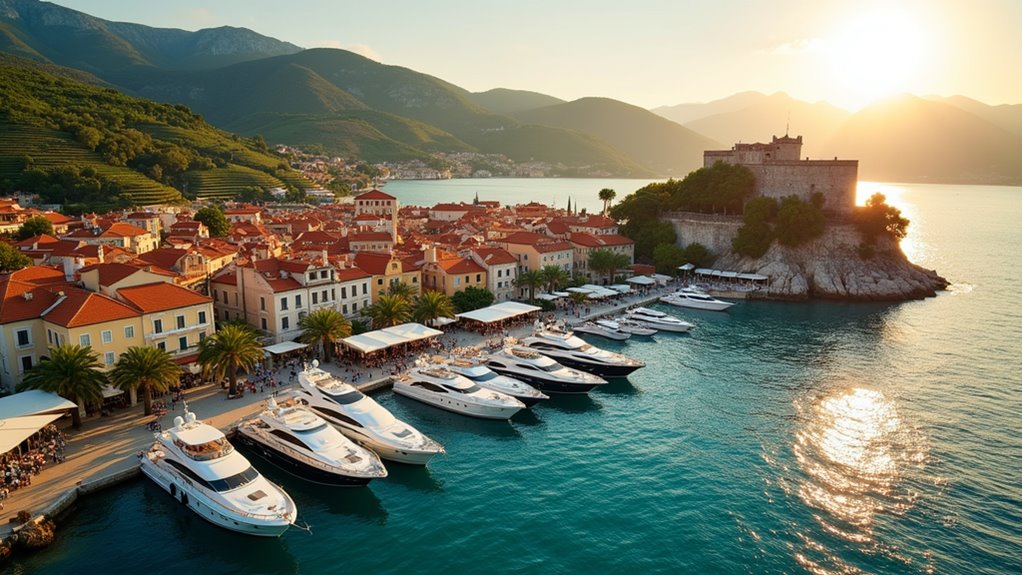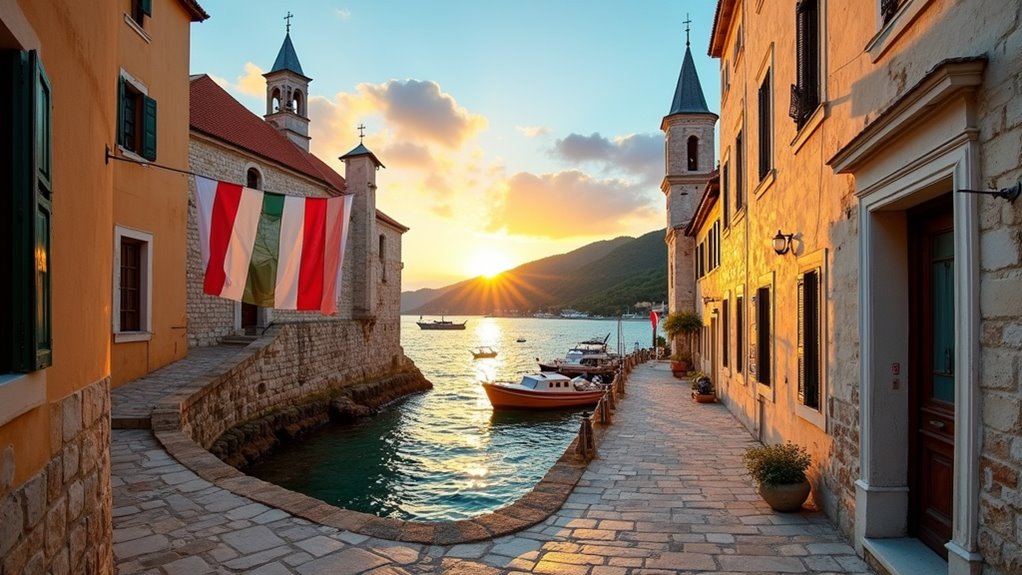Physical Address
304 North Cardinal St.
Dorchester Center, MA 02124
Physical Address
304 North Cardinal St.
Dorchester Center, MA 02124

Mediterranean paradise awaits across Croatia's seven stunning islands, where ancient towns meet azure waters and hidden coves beckon adventure-seekers.
Croatia’s seven best islands offer something for every traveler. You’ll find luxury and nightlife on Hvar, untouched serenity on Vis, and natural wonders in Mljet National Park. Korčula boasts Venetian architecture and Marco Polo’s birthplace, while Krk delivers accessible medieval towns. Don’t miss Rab’s sandy coves and distinctive bell towers, or the Pakleni Islands’ pristine beaches. Each island combines stunning landscapes with unique cultural experiences that will transform your Adriatic adventure.

While the Adriatic Sea boasts many jewels, Hvar functions as Croatia’s premier island destination for travelers seeking sophistication and vibrant energy.
You’ll find world-class accommodations like the rooftop-pooled Adriana Spa Hotel and celebrity-frequented Maslina Resort. The island also boasts the exquisite Palace Elisabeth, a 5-star luxury heritage hotel steps from the water and main square. As sunset approaches, the island transforms—head to Hula Hula Beach Club for seaside cocktails or dance until dawn at Veneranda Club, housed in a 13th-century monastery.
Beyond the glamour, Hvar’s 2,400-year-old wine culture thrives. Tour the UNESCO-listed Stari Grad Plain where ancient Greek vineyards still produce exceptional Plavac Mali and Pošip varieties. Like European capitals compared, Hvar offers a perfect balance of historical charm and modern amenities. Don’t miss Duboković’s underground cellars or Zlatan Otok’s award-winning tastings.
Complete your visit with Hvar Town’s historic treasures including Europe’s oldest public theater and the stunning Renaissance-Baroque St. Stephen’s Cathedral.
Unlike its glamorous neighbor Hvar, Vis enthralls visitors with its untouched tranquility as Croatia’s most remote inhabited island. You’ll discover a landscape shaped by history, where rocky terrain meets verdant hills and pristine beaches.
While Hvar dazzles with glamour, Vis captivates through pristine solitude—a remote Croatian haven where history and natural beauty intertwine.
Vis served as the Yugoslav Partisan headquarters during WWII and remained a military base until 1989, preserving it from over-development. Today, you can explore underwater caves while diving among diverse marine life, or venture to Kraljičina Špilja to marvel at natural formations. After an active morning of exploration, enjoy a traditional Croatian breakfast featuring local delicacies before continuing your island adventures.
The island’s peak, 587-meter Hum, offers spectacular panoramic views. When you’re ready to relax, enjoy the Mediterranean climate while sampling local wines—viticulture thrives here alongside fishing traditions. The distinctively crafted falkuša fishing boats, developed by Komiža’s fishermen, represent the island’s rich maritime heritage.
With just over 3,300 residents spread across its 90 km², you’ll find authentic Croatian island life at its most serene.

Nestled in southern Dalmatia between Dubrovnik and Korčula, Mljet functions as Croatia’s eighth largest island and a true ecological treasure. Nearly a third of this 37-kilometer-long island is protected as a national park, established in 1960 to preserve its breathtaking Mediterranean ecosystem.
You’ll find the park’s centerpiece in its two saltwater lakes – Veliko and Malo Jezero. Don’t miss the Isle of St. Mary in Veliko Jezero, home to an ancient Benedictine monastery that speaks to the island’s affluent history. The monastery now functions as a café and restaurant where visitors can relax after exploring.
For the best experience, explore the quiet hiking and biking trails that wind through the lush landscape.
Base yourself in either Polače or Pomena for easy access to the park’s natural attractions.
With its diverse coastline featuring beautiful bays and caves, Mljet offers the perfect balance of cultural heritage and unspoiled nature. Like summer in Marbella, visiting Mljet provides an alluring blend of natural beauty and cultural experiences that makes it irresistible to travelers.
Korčula Island emerges from the Adriatic Sea as a mesmerizing blend of history and natural beauty. Often called “Little Dubrovnik,” the island’s well-preserved Venetian architecture transports you back in time as you wander through its medieval old town.
A gem of Venetian-inspired streets where the Adriatic’s cerulean beauty meets medieval splendor
You’ll find yourself walking in the footsteps of Marco Polo, who was reportedly born here in 1254. His alleged birthplace is now a museum worth exploring.
Beyond historical attractions, Korčula’s rugged terrain offers spectacular hiking trails that wind through dense pine forests and past marble quarries. The island has a rich history of white marble quarrying that dates back centuries.
Don’t miss the charming coastal villages of Lumbarda and Rascisce, or the opportunity to sample local wines and olive oils.
With peaks reaching 568 meters, you’ll enjoy breathtaking views of the Adriatic from several vantage points across this 279-square-kilometer island paradise.
Couples seeking a romantic getaway will find Korčula’s secluded beaches and intimate waterfront restaurants perfect for Adriatic romance away from crowded tourist destinations.

Known as Croatia’s golden island, Krk offers travelers the rare combination of medieval charm and modern convenience. You’ll reach this gem via the Krk Bridge—no ferries needed—with excellent road connections making it ideal for day trips or longer stays.
Explore the five medieval towns including walled Krk Town and cliff-perched Vrbnik, famous for its Žlahtina wine and impossibly narrow Klancic Street. While exploring Krk, visitors often compare its picturesque medieval towns to those found in Scandinavian countries like Denmark and Sweden. The island’s rich history dates back to early Illyrian settlements that established the foundations for its cultural development. Don’t miss the Frankopan Castle or St. Lucy’s Church, home to the 11th-century Glagolitic Baška Tablet.
Time your visit for the Krk Summer Festival to experience medieval music and folklore performances. Beyond cultural attractions, you can discover hidden treasures like Kosljun Island’s Franciscan monastery and the stalactite-filled Biserujka Cave near Dobrinj.
Often called the “Happy Island,” Rab enchants visitors with a perfect blend of natural beauty and historical opulence. Located in the Kvarner archipelago, this 91-square-kilometer gem boasts one of Croatia’s most densely forested landscapes, with Mount Kamenjak rising 408 meters above the Adriatic.
You’ll discover sandy coves perfect for swimming and snorkeling along Rab’s coastline, a rarity among Croatia’s typically pebbly beaches. The island’s three limestone ridges create a stunning backdrop for hiking trails that lead to over 300 freshwater springs. The island has become increasingly popular with digital nomads seeking a perfect balance of work and leisure in a picturesque Mediterranean setting.
Don’t miss the medieval architecture in Rab Town, where influences from Illyrian, Greek, and Roman civilizations create a mesmerizing cultural mosaic. The town’s skyline is distinctively marked by four bell towers standing in a line along the ridge overlooking the old town. Sample traditional cuisine that reflects the island’s Mediterranean heritage while staying in accommodations ranging from charming apartments to luxury hotels.

Just off the coast of Hvar, the Pakleni Islands form an emerald archipelago that’s become legendary among water sports enthusiasts. Despite their “hellish” name (actually derived from “paklina,” the pine resin once used to waterproof ships), these 16-21 islands offer heavenly experiences.
The Pakleni Islands—a green archipelago with a devilish name but paradisiacal experiences for water lovers.
You’ll find pristine azure coves on Jerolim and Vodenjak, perfect for escaping crowds. St. Clement, the largest island, features excellent hiking trails connecting to secluded vineyards. The archipelago stretches approximately 10 kilometers long from west to east across the Adriatic Sea.
For adventure seekers, the steady Meltemi winds create ideal sailing conditions, while rocky formations near St. Clement provide fascinating dive sites. Unlike Ibiza with its premium price tags, the Pakleni Islands offer remarkable natural beauty at more accessible costs.
Access is easy via hourly water taxis from Hvar Town, but consider renting a private boat for maximum freedom. The ACI Palmižana Marina serves as your jumping-off point to explore this paradise of hidden beaches and crystal waters.
Croatia’s islands aren’t just dots on a map; they’re your ticket to paradise! You’ll kick yourself if you miss Hvar’s lavish parties or Vis’s secret caves. Why settle for ordinary vacations when you could be swimming by an ancient monastery on Mljet? Don’t be that traveler who returns with boring stories—embrace these seven gems and you’ll finally have Instagram photos worth showing off!